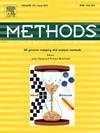Detection of hypochlorous acid fluctuation via a near-infrared fluorescent probe in Parkinson’s disease cells and mouse models
IF 4.3
3区 生物学
Q1 BIOCHEMICAL RESEARCH METHODS
引用次数: 0
Abstract
Parkinson’s disease (PD) is a neurodegenerative disorder caused by excessive reactive halogen species leading to the death of dopaminergic (DA) neurons, which disrupts the coordination of normal physiological structures and functions. Hypochlorous acid (HOCl) is a reactive halogen species whose overproduction is associated with the death of DA neurons. Herein, overproduction of HOCl may be a neurotoxin substance in the pathogenesis of PD. Therefore, it is essential to understand the disease of HOCl in PD model. However, early detection HOCl in PD model remains lacking of effective methods. In this study, a high sensitivity off–on near-infrared probe (MB-HOCl) was designed and synthesized. MB-HOCl showed a quantitative response toward HOCl (0–100 μM) with detection limit of 0.32 μM. Importantly, MB-HOCl was capable of selectively and specially detecting exogenous and endogenous HOCl in PC-12 cells and was successfully used for imaging in PD mice models. All results demonstrate that the probe (MB-HOCl) holds great promise for understanding the disease and diagnosis of HOCl-mediated PD models.

用近红外荧光探针检测帕金森病细胞和小鼠模型中的次氯酸波动。
帕金森病(PD)是一种神经退行性疾病,由反应性卤素过量导致多巴胺能(DA)神经元死亡,破坏正常生理结构和功能的协调。次氯酸(HOCl)是一种反应性卤素,其过量产生与DA神经元的死亡有关。因此,HOCl的过量产生可能是PD发病机制中的一种神经毒素物质。因此,了解HOCl在PD模型中的病变是十分必要的。然而,PD模型HOCl的早期检测仍缺乏有效的方法。本研究设计并合成了一种高灵敏度的近红外探测器(MB-HOCl)。MB-HOCl对HOCl(0 ~ 100 μM)有定量响应,检出限为0.32 μM。重要的是,MB-HOCl能够选择性和特异性检测PC-12细胞中的外源性和内源性HOCl,并成功用于PD小鼠模型的成像。所有结果表明,探针(MB-HOCl)在了解hocl介导的PD模型的疾病和诊断方面具有很大的希望。
本文章由计算机程序翻译,如有差异,请以英文原文为准。
求助全文
约1分钟内获得全文
求助全文
来源期刊

Methods
生物-生化研究方法
CiteScore
9.80
自引率
2.10%
发文量
222
审稿时长
11.3 weeks
期刊介绍:
Methods focuses on rapidly developing techniques in the experimental biological and medical sciences.
Each topical issue, organized by a guest editor who is an expert in the area covered, consists solely of invited quality articles by specialist authors, many of them reviews. Issues are devoted to specific technical approaches with emphasis on clear detailed descriptions of protocols that allow them to be reproduced easily. The background information provided enables researchers to understand the principles underlying the methods; other helpful sections include comparisons of alternative methods giving the advantages and disadvantages of particular methods, guidance on avoiding potential pitfalls, and suggestions for troubleshooting.
 求助内容:
求助内容: 应助结果提醒方式:
应助结果提醒方式:


